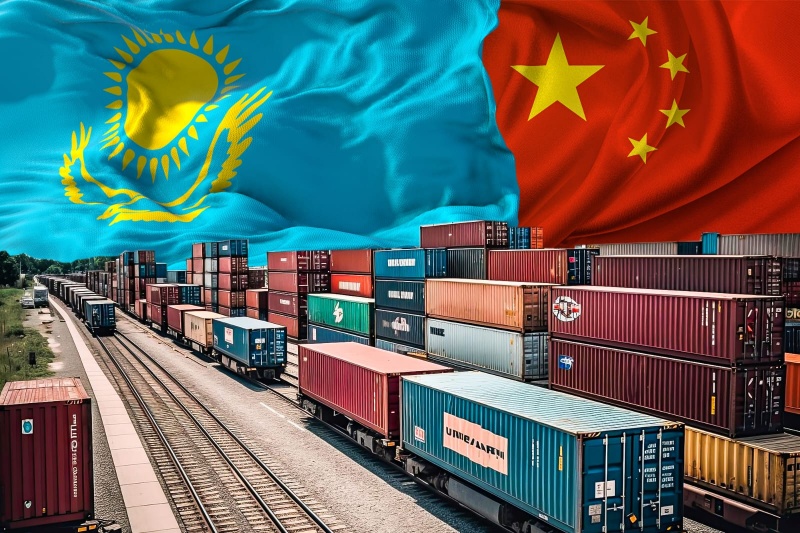
16.10.2023
China’s Belt and Road Initiative is one of the most ambitious infrastructure mega projects of the modern world.
We are proud that BRI was first announced in Astana, the capital of Kazakhstan. It is very symbolic that this year it is 10 years since BRI commencement, and last year Kazakhstan and China celebrated 30th anniversary of the establishment of diplomatic relations. Belt and Road Initiative has become an expression of good cooperative and beneficial relations between China and Kazakhstan.
Belt and Road Initiative has become not only a recognizable brand of Chinese diplomacy, but also a real tool for international cooperation in modern geopolitical conditions creating new drivers for economic growth to promote building a community of shared future for mankind.
Kazakhstan is favorably located in the very center of Eurasia. In order to enhance existing transit potential, the national economic modernization program «Nurly Zhol» (Bright way) has been adopted in 2015 to boost economy through wider construction of infrastructure and upgrade connectivity between East and West.
China and Kazakhstan identified the main directions of joint work on the integration of Kazakhstan’s «Nurly Zhol» program with the Belt and Road Initiative. Both megaprojects prioritize transport, logistics, industry, energy, agricultural exports, infrastructure, education, human capital development, and support for small and medium-size businesses.
Today, the territory of Kazakhstan is crossed by 11 transcontinental routes – 5 railway and 6 automobile. Over the past 10 years, Kazakhstan has invested about 30 billion dollars in the development of infrastructure, transport and logistics assets and competence. Gradually, Kazakhstan plans to transfer from agricultural and energy based to diversified service economy based on transshipping, logistics, warehousing and added value manufacturing.
The implementation of Belt and Road initiative is strategically beneficial for Kazakhstan. Thanks to the cooperation with the PRC, Kazakhstan has gained access to the sea, facilitating cross-border exchange between East and West.
Kazakhstan, in line with its geographical location in the heart of Eurasia, aims to sustain commercial, economic, investment, political and cultural relations between and beyond its surrounding regions.
Kazakhstan actively participates in expanding transport corridors connecting China and Kazakhstan with Central, Western and South Asia, and Europe.
From a geopolitical perspective, the implementation of the rail corridors will further enhance Kazakhstan’s multi-vector strategy. Kazakhstan can emerge as a key East-West Transit Hub.
Thanks to China’s BRI, Kazakhstan has secured new access to international trade by exporting its high-quality wheat to South-East Asia which would not otherwise be possible due its landlocked location.
In particular, China-Kazakhstan International Logistics Base was the first facility built since Belt and Road Initiative commencement. Stretching over 4,000 kilometers, it connects the eastern port of Lianyungang to Horgos at the border with Kazakhstan delivering large imports and exports of grain and iron to and from Japan, South Korea and Southeast Asia.
It takes only 6 days for the trains to go from Lianyungang to Almaty.
Strategic location in the junction of both the Silk Road Economic Belt and the 21st-Century Maritime Silk Road, made it the best sea gate to Southeast Asian countries.
It is well known fact that the world has a large infrastructure gap constraining trade, openness and future prosperity. Much of the global investment deficit covers key connectivity sectors important to the BRI, such as transportation, energy, water and telecommunications. Addressing these needs will therefore remain an essential priority on the international development agenda to support economic development and avoid geographical boundaries.
China’s proposal to further promote liberal trade and broad cooperation is consistently shaping «Asian version» of globalization. The prediction that the 21st century will be the century of Asia has become a reality today. 28% of world GDP is already concentrated in Asia.
Despite political tension, sanctions and trade wars, the volume of trade under BRI is growing. In particular, China’s trade volume with BRI nations hit over $2 trillion which is one third of China’s total foreign trade in 2022.
The world is increasingly gravitating towards geo-economics and joint development. Belt and Road Initiative represents much more than just a set of new opportunities for economic cooperation. The initiative reflects the strong historical demand from more than 150 countries of the world for security, free trade and prosperity. Indeed, thanks to the efforts of China and all partners involved, the modern Silk Road is becoming a belt of stability and development.
The China-Central Asia Summit hold on May 18 and 19 in Xi’an introduced infrastructure and other trade and development measures to further enhance trade and investment cooperation. In 2022 China – Central Asian regional trade hit US$70 billion.
The 5+1 Regional Dialogue (Central Asia plus China) promoted by Beijing, aims to make the development of the Belt and Road Initiative systematic, which should also ensure the continued development of transit routes through Central Asia. By embedding in the East-West transport communications, the problem of continental isolation is being eliminated, and strong prerequisites for intra-regional cooperation are being created. Thus, with the support of China, today Central Asia has an opportunity for economic renaissance.
It is obvious that the modern Silk Road is changing the world order and creating a new global reality.
I am confident that the Belt and Road Initiative, which represents the reconstruction of the Great Silk Road of the 21st century, has become the most striking event of the current century. It reflects the rise and grandeur of modern Asia.
Cooperation along the Belt and Road has a strong impact on the prosperity and progressive development of several billion people around the world. I am confident that the Belt and Road Initiative will become a good basis for building a Community of Common Destiny for All Mankind.
The China Studies Center of Kazakhstan supports further research and cooperation with international Think Tanks, media and other organizations to build global partnerships around China Studies and BRI through open dialogue, joint projects and knowledge sharing.
China Studies Center
(photo https://rail-news.kz/ru/news)
